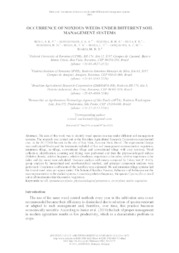Occurrence of noxious weeds under different soil management systems.
Occurrence of noxious weeds under different soil management systems.
Autoria: MELO, A. K. P.; ALBUQUERQUE, J. A. A.; SIQUEIRA, R. H. S.; SILVA, E. E. da; MEDEIROS, R. D. de; SOUZA, K. T. S.; SOUZA, L. T.; GONÇALVES, A. C. M.; SOARES, M. B. B.
Resumo: The aim of this work was to identify weed species in areas under different soil management systems. The research was carried out in the Brazilian Agricultural Research Corporation experimental area, in the 2017/2018 harvest, in the city of Boa Vista, Roraima State, Brazil. The experimental design was randomized blocks and the treatments included of five soil management systems (native vegetation, minimum tillage, no-tillage, conventional tillage and conventional tillage with crop rotation). Weed collection, identification, counting and drying were performed and then the phytosociological indices (Relative density, relative frequency, relative abundance, importance value index, relative importance value index and dry mass) were calculated. Variance analysis with means compared by Tukey test (P <0.05), group analysis by hierarchical and non-hierarchical method, and principal component analysis were performed. Correlation coefficients of the variables were estimated. No and minimum tillage systems had the lowest weed rates per square meter. The botanical families Poaceae, Fabaceae and Rubiaceae are the most representative in the studied systems. Concerning relative frequency, the species Cyperus flavus stood out in all treatments other than native vegetation.
Ano de publicação: 2021
Tipo de publicação: Artigo de periódico
Unidade: Embrapa Roraima
Palavras-chave: Cover plant, Native vegetati, Phytosociological parameters, Spontaneous plants
Observações
1 - Por padrão são exibidas publicações dos últimos 20 anos. Para encontrar publicações mais antigas, configure o filtro ano de publicação, colocando o ano a partir do qual você deseja encontrar publicações. O filtro está na coluna da esquerda na busca acima.
2 - Para ler algumas publicações da Embrapa (apenas as que estão em formato ePub), é necessário ter, no celular ou computador, um desses softwares gratuitos. Sistemas Android: Google Play Livros; IOS: iBooks; Windows e Linux: software Calibre.
Acesse outras publicações
Acesse a Base de Dados da Pesquisa Agropecuária (BDPA) para consultar o acervo completo das bibliotecas da Embrapa.

